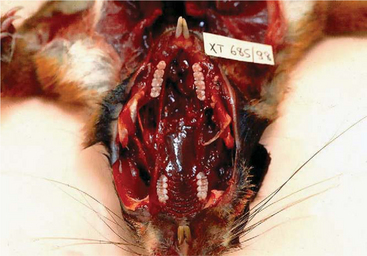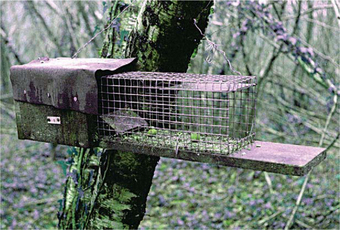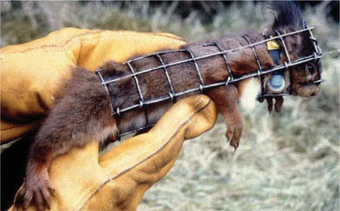Chapter 29 Medical Aspects of Red Squirrel Translocation
This chapter is based on work in the United Kingdom (U.K.) on the translocation of red squirrels (Sciurus vulgaris) for conservation purposes. The other species of squirrel present in the U.K. is the grey (gray) squirrel (Sciurus carolinensis), an alien species introduced from the United States in the nineteenth century. Both these species are diurnal tree squirrels (order Rodentia; subfamily Sciurinae). There is no attempt to cover translocation for rehabilitation purposes, already described in Sainsbury,24 although many of the principles are the same.
BIOLOGY
Both the red and the gray squirrels inhabit conifer and broadleaf forests, as well as urban parks and gardens with mature trees. They are solitary for much of the time, but communal nesting may occur during winter and spring. Dominance hierarchies are not dependent on gender; larger and older animals are more dominant.14 Red squirrel densities are lower (0.3-1.0 squirrel per hectare [ha]) than gray squirrels in broadleaf woods (2-8 squirrels/ha) but tend to be similar in conifer woods (0.03-1.3 squirrels/ha) (1 ha = 2.47 acres). Aggressive encounters within species are rare but may result in bites to the ears, dorsum, rump, or tail. Encounters between red and gray squirrels are usually amicable.34 Scent marking occurs on specific branches or tree trunks using urine and possibly secretions from mouth glands by face-wiping behavior.
Dispersal of juveniles and some adults principally occurs during the autumn and occasionally at other times of the year. These squirrel species do not hibernate and are active all year, although they may remain in their nest (drey) for 2 or more days during severe winter weather.14 There is an annual cycle of numbers, with a peak after breeding in the autumn, overwinter losses, and a low point in spring before recruitment.
The diet of free-living red or gray squirrels consists principally of tree seeds, such as hazelnuts, beech mast, acorns, and conifer seed, as well as fruits, berries, and fungi. Other foods include buds, shoots, flowers, bark, invertebrates, and lichen.14 There are reports of squirrels eating bones found in their environment2,4,7 and in captivity.9 Feeding signs for squirrels include hazelnuts split open, leaving two pieces of shell with clean edges; characteristic “cores” of conifer cones, with associated piles of stripped scales with clean-cut edges (rather than the ragged edges made by birds); and bark stripping.14
UNIQUE ANATOMY
Red squirrels weigh between 270 and 320 g when adult; gray squirrels are heavier and weigh between 500 and 600 g. The body weight may increase in the autumn by as much as 10% in red squirrels and 17% to 13% in gray squirrels.14 Females have four pairs of nipples. The scent glands are present at the commissure of the mouth and in the upper and lower lips.
As with many other rodents, the genders may be differentiated by the distance between the genital opening and the anus, which is short in females and about 10 mm in adult males. The reproductive tract regresses in the autumn and perhaps in the winter if food supplies and weather are poor.14 The feces are cylindrical or round, slightly smaller than those of rabbit (8 mm in diameter), and dark gray to black but vary according to the diet.14
Dentition
Incisors in squirrels, as in other rodents, grow continuously, and the lower incisors in particular occupy long sockets. The incisors have an enamel coating on the full length of their labial surfaces, whereas at the buccal aspect only the softer dentin is present, so the incisors are worn to a chisel-shaped cutting edge (Figure 29-1). The dental formula in both red and gray species follows; the first upper premolar is rudimentary and vestigial.14
Red squirrels’ lower incisors erupt at 19 to 21 days of age and the upper incisors at 31 to 42 days.14 The cheek teeth (molars and premolars) erupt from 7 weeks of age onward, and by 10 weeks all the cheek teeth are present. Primary first lower and only the second upper premolars are shed at 16 weeks and are replaced by permanent teeth. There are no canine teeth, and a diastema exists between the incisors and the cheek teeth.24 The cheek teeth are quadrate with rounded, blunt, cone-shaped, bunodont marginal cusps and a concave central area (fossa) on their occlusal surfaces (see Figure 29-1). The occlusal surfaces of the upper cheek teeth are traversed by weak, transverse ridges.14 A young squirrel has a layer of enamel covering the surface of each cheek tooth, including the cusps and ridges. This layer becomes worn with age, exposing the underlying dentin.29
RESTRAINT AND HANDLING
Physical Restraint
A variety of live traps are available to capture squirrels. Red squirrels are best captured in a single-capture trap with a removable nest box attached16 (Figure 29-2). Gray squirrels, on the other hand, may be trapped in multicapture cage traps.15 A license may be required to trap squirrels. Red squirrel traps are prebaited with apple, carrot, corn, peanuts, sunflower seeds, and hazelnuts for up to a week before setting. Gray squirrel traps are usually baited with whole corn.
One method to remove the trapped squirrel is to encourage it to leave the nest box or trap and enter a burlap (hessian) sack. For example, the mouth of the sack may be closed firmly around the nest box, with the lid of the box removed at the same time. Most squirrels will voluntarily enter the sack, then may be confined to a corner. The physical form of the squirrel may be detected through the sack, and the squirrel may be safely restrained by placing downward pressure on the dorsum, using the thumb and forefinger to control the head and neck and the remainder of the hand to control the body. The sack’s mouth may then be reflected to examine the squirrel and, if necessary, apply a malleable rubber face mask to induce anesthesia.
Alternatively, squirrels may be transferred from a nest box to a suitably sized handling cone constructed of wire mesh (230 mm long and 20 mm in diameter at mouth of cone), in which they may be examined or anesthetized using a face mask (Figure 29-3). The squirrel will voluntarily run into the cone and may then be prevented from reversing by placing a finger behind it.
Chemical Immobilization
Ketamine at approximately 40 mg/kg body weight by intramuscular (IM) injection will provide sedation that wanes over approximately 1 hour. Flecknell12 found that a combination of medetomidine (0.5 mg/kg) and ketamine (75 mg/kg) administered in the same syringe by intraperitoneal injection provided effective anesthesia (although not necessarily for major surgery) in rats. Routh22 used this combination of agents by IM injection in gray squirrels. Partial reversal of anesthesia with atipamezole (1 mg/kg subcutaneously) is possible. (In rats, this should not be attempted until 20 minutes or more after induction because of the undesirable effects of ketamine.)
ANESTHESIA
As in all small mammals with a high surface area/body weight ratio, additional heat may be needed for red squirrels during anesthesia to maintain body temperature. Anesthesia may be safely achieved using isoflurane at 1% to 4% in oxygen administered by a malleable face mask. Intubation is difficult, but Flecknell’s method12 for rats could be used as follows: the squirrel is positioned in dorsal recumbency and the tongue pulled gently forward and to one side. The larynx is visualized with a purpose-made laryngoscope.5 The larynx may then be intubated with an intravenous cannula (12-16 gauge) using a suitable speculum. A small piece of rubber tubing or some Micropore tape (3M, Loughborough), positioned around the catheter about 5 to 10 mm from its tip, will prevent a bronchus being entered or leakage of gas around the tube, making ventilation more effective.
Stay updated, free articles. Join our Telegram channel

Full access? Get Clinical Tree






